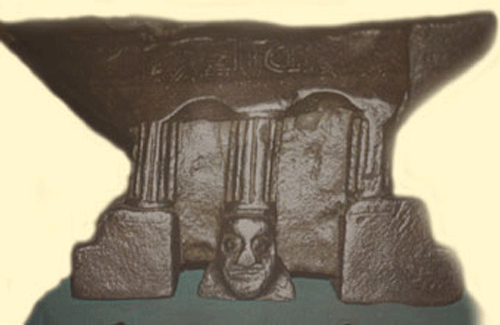If there are images of the Devil clearly standing on an anvil, I do not have any copies!
This, however, does not mean that as concept it is far-fetched, for there are relatively common connections between Smiths and their forges and the Devil - from St Dunstan and the Devil to relatively well-known tales such as those of Volundr (or Volund), this latter at times somewhat identified with the Devil (and having similar tones to Hephæsteus).
Even the Auzon Casket, by the way, depicts a scene split in two: on the left from Volundr, on the right the adoration of the Magi. This dichotomy may indicate opposites, and hence in a way further connect and identify the forge/anvil with devilish engagements.
I was trying to find a reference I once had that makes close connections between smiths (and hence the forge and the anvil) with the Devil, and simply cannot find it. What an internet search did uncover, however, is the following paragraph from a '
The Smith And The Devil':
With the possible exceptions of the wolf, the raven and the crone, no one has a closer mythological connection with malevolence than the smith. One of the archetypes of northern European folklore is Wayland, the divine but evil blacksmith tutored by the trolls. He was maimed (becoming lame, like Hephaestus, the smith-god of the Greeks) and imprisoned by the legendary King Niduth, who forced him to use his magical skills to make trinkets for the court. The vengeful Wayland [ie, Volundr] lured the king’s children into his forge, raped his daughter, killed his sons and turned their skulls into goblets from which the unwitting king drank. Then he fashioned himself a pair of wings and flew away cackling with delight. Throughout northern Europe his unquiet wight is said to haunt the Neolithic burial mounds reputed to be his smithies.
(Strictly, the story does not seem to suggest that he
lured the children, but rather an episode presented itself in which the acts described took place.)
In terms of the anvil, it is of course clearly associated with the forge, and the forge with fire, and hence a connection to the fires of hell. Numerous images of Hell depict devils with fire-tongs and, at times, even showing forges... but must admit that I do not have an image of hell in which is a sword-forge (more on this in a second) upon which stands a/the Devil.
Going back to the image on Tarot de Marseille cards as anvil, it is not any kind of anvil, but the larger 'flat' variety also used for the making of swords. The Tarot de Marseille type-I shows more a forked prong that he holds. In the Tarot de Marseille type-II, however, it even seems that he holds (in his bare hand) a blade of steel flaming, as may indeed happen at the forge, adding to the way that this
may also have been considered and seen in earlier times.
Perhaps I've been seeing the item upon which the Devil stands as an anvil for so long that for me it has become too much of an acquired and 'unquestioned' way-of-seeing... so look forward to further discussion on this topic!




